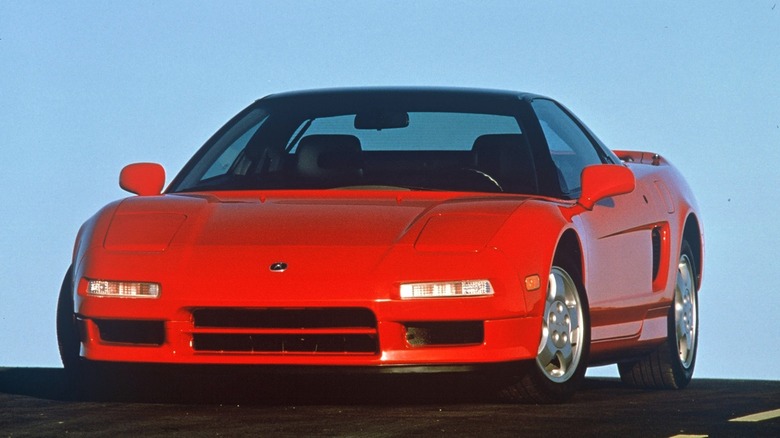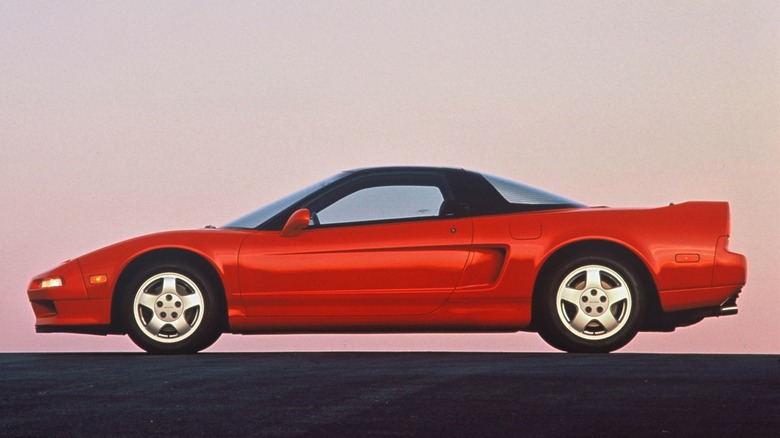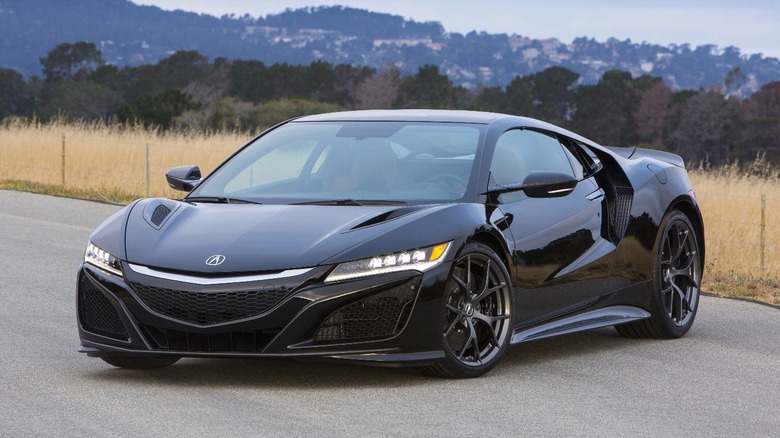Why Honda Discontinued The NSX (Twice!)
What is the greatest car ever built? While it's certainly debatable, many enthusiasts would argue that the McLaren F1 is. Not only was it the fastest car in the world at the time, but it was also one of the most expensive and best handling. It has been praised countless times for its stiff chassis, expertly honed suspension, responsiveness, and even its practicality. While the McLaren F1 might be one of the most celebrated supercars ever built, it owes a lot of its winning attributes to another car that was over thirteen times less expensive, the Honda NSX.
When Honda pulled back the curtains on the first generation NSX in 1989, it was clear to all in attendance that it was not only revolutionary for Honda, but the entire sportscar industry. The New Sportscar eXperimental, as its acronym denotes, was so impressive from a performance standpoint that Gordon Murray, the designer of the McLaren F1, stated in a letter to Honda that "the moment (he) drove the 'little' NSX, all the benchmark cars–Ferrari, Porsche, Lamborghini–(he) had been using as references in the development of (his) car vanished from (his) mind." Its reliability and usability were benchmarks in the sportscar world as well, with the NSX being one of the first serious sports cars to place an emphasis on practicality.
In theory, the NSX was the perfect car — and so was its follow-up, the also highly-praised second generation NSX — however, both generations got the ax following periods of miserable sales figures and shifts in the automotive climate.
Why was the first-generation NSX discontinued?
As soon as automotive journalists got their hands on the first-generation NSX, one resounding sentiment rang true across the board; the NSX was better than everything. Not only was it faster to 60 mph than the recently released Ferrari 348ts and Porsche 911 Carrera 4, but it toyed with them around the corners as well. It isn't a stretch to say that when the NSX came out, there was almost no negative input from anyone who drove one.
The NSX was so good because it was meticulously planned and engineered to be that way. The design team plotted the NSX's competitors on a graph with respect to their performance metrics. The NSX was the first production car to use an aluminum monocoque chassis to give it a numerically superior power-to-weight ratio than the rest. Its naturally aspirated V6 revved to 8,000 RPM so effortlessly that it wasn't a challenge for the car or driver. Not to mention, it was comfortable, it didn't rattle, and it didn't break down. Ironically, the NSX's ultimate superiority is where the problems began. Without the pomp and circumstance, the NSX hinged on being boring, at least when compared to other supercars of the time.
In a 1995 test, Car and Driver called the NSX "the brain surgeon's approach to go-fast operations," lacking the passion of more problematic but more macho established options. The relatively sterile nature of the NSX split supercar buyers who would rather be driving something with more occasion, which the arguably inferior Ferrari could offer. As a result, Honda only sold 18,000 units over its long 15-year production life. In contrast, Ferrari sold over 11,000 F355s in just 6 years between 1994 and 1999. The NSX's abysmal sales figures are what did the first-generation model in.
Why was the second-generation NSX discontinued?
Much like the first-generation NSX, the sequel second-generation NSX stuck it to the competition. When it was released in 2016, it featured an advanced hybrid electric system that rivaled the ones used in the far more expensive Porsche 918 Spyder, McLaren P1, and LaFerrari hypercars. It was one of the first hybrid-electric supercars that existed in a price bracket below $500,000, a market that is getting crowded in the modern day. Just like the initial NSX, the second generation fought above its weight class.
The second-generation NSX's twin-turbo V6 paired with its hybrid-electric powertrain made it good for 573 horsepower and 476 lb-ft of torque, placing it in the same category as cars like the Lamborghini Huracan and McLaren 570S. While the NSX was praised for its performance and versatile demeanor, it was never able to truly keep up with its non-hybrid competition. In a 2017 Car and Driver test, the second-gen NSX was outperformed by the Audi R8 V-10, McLaren 570S, and Porsche 911 Turbo S.
It is important to remember that when the second-gen NSX was released in 2016, hybrid supercars were still uncommon and the NSX's $157,800 base price was a lot to pay for an Acura that was attempting something new. Like with the first-generation NSX, demand for the second-gen just wasn't there. In the six years that the NSX was available, between 2016 and 2022, Acura only sold 2,548 units. Acura cited poor sales numbers and a desire to shift focus to electric vehicles as the reasons for the model's discontinuation. In more positive news, Jon Ikeda, senior vice president of Honda Racing Corporation, told The Drive in 2021 that the NSX will be back, strongly hinting that the third generation will be an EV.


